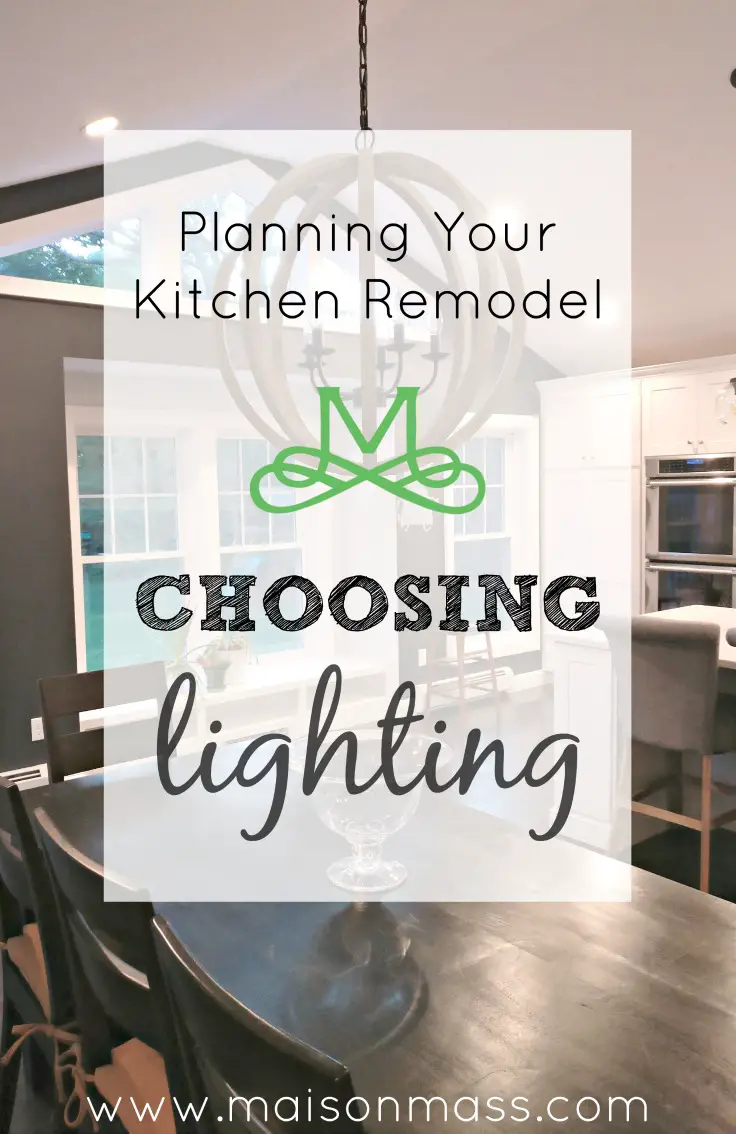Lighting is an integral part of architecture and room design – it is necessary to see and perform tasks, it creates a mood or ambiance and can even make a space seem larger and airier. No where is this more important than in the kitchen. A kitchen is first and foremost a work space so you’ll want ample lighting at all the work areas. But a kitchen often is an entertaining space too. So you’ll want to layer in options for softer lighting for parties. Choosing your kitchen lighting will have a big effect on the overall feel of your space – so we’re breaking it all down for you.
Types of Lighting
According to the American Lighting Association, there are three types of lighting that work together in your home and a good lighting plan incorporates all three:
- Ambient Lighting provides an area with overall illumination. Also known as general lighting, it radiates a comfortable level of brightness without glare and allows you to see and walk about safely. In some spaces such as laundry rooms, the ambient lighting also serves as the primary source of task lighting. It can be accomplished with chandeliers, ceiling or wall-mounted fixtures, recessed or track lights and with lanterns mounted on the outside of the home. Having a central source of ambient light in all rooms is fundamental to a good lighting plan.
- Task Lighting helps you perform specific tasks, such as reading, grooming, preparing and cooking food, doing homework, working on hobbies, playing games and balancing your checkbook. It can be provided by recessed and track lighting, pendant lighting and under cabinet lighting, as well as by portable floor and desk lamps. Task lighting should be free of distracting glare and shadows and should be bright enough to prevent eye strain.
- Accent Lighting adds drama to a room by creating visual interest. As part of an interior design scheme, it is used to draw the eye to houseplants, paintings, sculptures and other prized possessions. It can also be used to highlight the texture of a brick or stone wall, window treatments or outdoor landscaping. To be effective, accent lighting requires as least three times as much light on the focal point as the general lighting surrounding it. Accent lighting is usually provided by recessed and track lighting or wall-mounted picture lights.
Choosing Kitchen Lighting
Let’s apply the three types of lighting to the kitchen and look at the fixtures you’ll want to consider for your new space:
Can or recessed lights for general room lighting
Recessed lights are a great choice to illuminate the overall space. They will provide the ambient lighting you’ll need in your room. These lights are a good candidate for a dimmer to change the mood of the room while you are entertaining. This can be especially important in open concept homes where the living room and kitchen may be attached.
The contractor or electrician will ask you how many cans you want and where you want them placed, so its a good idea to plan that out ahead of time. In general, you’ll want a can above your sink and one above your stove (if you don’t have lighting in your hood vent) to illuminate those areas. Starting from those placements, the rule of thumb is to take the height of your ceiling and divide by two for spacing. So for example, if you have eight foot ceilings, you’ll want to space the lights four feet apart around the perimeter of the room about 30″ from the walls to avoid casting shadows. If the kitchen is large, you might need some in the middle as well.
Under cabinet lights to illuminate countertops
Under cabinet lights are a great choice for task lighting over countertops. The fixtures should be placed at the front of the cabinet (not back by the wall) to ensure the entire countertop is illuminated. There are a variety of types of under cabinet lighting available but the trend is moving toward LED lighting for this type of fixture because it is cooler than other lighting. Under cabinet lighting comes in strips, tape or pucks. All are thin enough to be hidden underneath the cabinet when you are looking at it straight on. Strip and tape lighting offer the most consistent light along the length of the cabinets while puck lighting will give a spot effect on the counters. Most people are opting for strip or tape lighting under their cabinets.
You can also use this type of lighting as accent lighting for open cabinets (as shown above) or cabinets with glass doors. If you have china, beautiful crockery or other items you’d like to highlight either the strip or puck lights used for under cabinet lighting can be used inside the cabinet as well as accent lighting. Many people feel that puck lights are the better choice for accent lighting in open cabinets.
Ultimately, the choice is yours. For more detailed information, Yale Appliance & Lighting has a great overview of the under cabinet lighting options on the market today and Pegasus Lighting has a comprehensive free eBook on the subject that you can download.
Pendant lights for islands and peninsulas
Pendant lights are another source of task lighting specifically used over islands or peninsulas. Often called mini pendants to differentiate from full-sized pendant lights, these are ubiquitous in kitchens with islands these days. The American Lighting Association recommends you mount each pendant so that the bottom of the shade is approximately 66″ above the floor so it is possible to look across the room below the pendants. If the shades are not very deep and there is seating at the kitchen island or peninsula, install the pendants a few inches lower (60″ above the floor). They also suggest that you install one pendant for every two feet of counter space. So for example, if you have a six foot long island, you’d have 3 pendants. Finally they recommend that if possible, you should use an odd number of pendants to create a better sense of balance.
Pendants not only function as light sources, but also are a design element in your kitchen. They are a chance to add a bit of wow to your space. There are myriad options for mini pendants on the market in any style you choose, from industrial to farmhouse to traditional. It can be a great place to bring in an accent color or texture you might be using in the kitchen. For example, maybe you’ve opted for brushed gold cabinet hardware, choosing a pendant with brushed gold can help tie the room together.
Ceiling light for over a kitchen table
For eat-in kitchens, you’ll want to choose a larger pendant light or ceiling light to hang over the kitchen table. This gives task lighting for dining, homework and whatever else you might be working on at the table. This is another chance for you to bring in an element of style to the kitchen.
The kitchen table light and the mini pendants over an island need not match. Indeed, most designers would tell you to steer clear of having the same light in both applications. You can freely choose the look or style you are going for in the kitchen and mix and match light fixtures. To ensure the space feels cohesive, its a good idea to make sure the lights have at least one or two common elements (for example, both have glass shades or both hang from black chains).
Again, the American Lighting Association has some guidelines for hanging kitchen lights: mount pendant fixtures 30″ above the table top. If your table is round, the fixture should ideally be 12″ narrower than the diameter of the table. For square and rectangular tables, choose a fixture that is 12″ narrower than the smallest side.
The Bottom Line on Kitchen Lighting
Choosing kitchen lighting can be a very enjoyable experience – its fun to look at all the beautiful fixtures on the market today. Sketch out a plan using the lighting guidelines above and share it with your contractor and/or electrician to get their input. Of course, a lighting showroom is a great place to see the lights in person and you’ll benefit from the expertise and knowledge of the staff – however, their prices tend to be higher. Light fixtures can be incredibly expensive – especially larger statement pieces. Most fixtures are available somewhere on-line, so it makes sense to do your homework and shop around.
Good luck!
Kristen
Need to catch up on other posts in our Kitchen Remodel series?
Gathering Inspiration
Budgeting
Design Guidelines
Cabinetry
Countertops
Backsplash
Flooring
Appliances

















